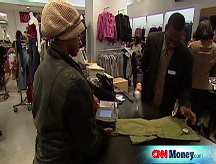Consumer prices fall by record 1.7%
Inflation for consumer products falls by a record amount in November for second-straight month, dragged down by falling energy prices.
NEW YORK (CNNMoney.com) -- Consumer prices - dragged down by plunging energy costs - fell by a staggering amount in November, the government reported Tuesday.
The Consumer Price Index, a key inflation reading, fell 1.7% last month, according to the Labor Department. That was much weaker than October's 1% drop and exceeded the 1.3% decline forecast by a consensus of economists surveyed by Briefing.com.
Prices fell by the greatest amount since the Department of Labor began publishing seasonally adjusted changes in February 1947.
"It's a further sign of the difficult environment we're in," said Terrin Griffiths, a former Labor Department employee and currently an economist at the California Credit Union League. "Households are reacting to the economy, and producers continue to lower prices to entice consumers to spend."
The decline marked the second straight month that prices fell by a record amount, worrying some economists that a disturbing trend of deflation - the opposite of inflation - may be on its way.
Though falling prices may seem like a good thing for consumers, deflation is generally bad for the economy. If prices fall below the cost it takes to produce products, businesses will likely be forced to cut production and slash payrolls.
Rising unemployment would cut demand even further, sending the economy into a vicious circle. Deflation usually represents a system-wide contraction in demand, with consumers waiting on the sidelines as they wait for prices to decline even further.
Economists expect more drops in consumer prices for several months, but most say deflation is still a long way off. Deflation usually represents large, sustained drops in consumer prices, but so far the economy has only recorded two consecutive declines.
"It's a bit premature to say we're in a period of deflation," said Anika Khan, economist at Wachovia. "We've had two months of record declines, [and] deflation may be a far-off worry if that continues."
Tuesday's report is just further indication that consumers have dramatically shifted their spending habits in the past few months, opting to save money or pay down debt rather than spend it.
A separate report released by the Federal Reserve last week showed American household debt fell for the first time ever in the third quarter, as net worth dropped by the largest amount on record based on data going back to 1951.
"This is all about the psychology of consumers," said Khan. "When they feel better about the job market and housing and stock prices, they'll start shopping more."
Consumer prices have performed a virtual about-face beginning in September. For most of the year, high energy prices have caused consumer prices to soar, reaching a 17-year high in July. But energy prices have fallen about 70% since then, as the credit crunch deepened.
Demand for consumer products has fallen precipitously in recent months, after the credit crunch exploded into a crisis in mid-September. Loans have been expensive and hard to come by for those who want to make purchases for big-ticket items, and consumer confidence remained near an all-time low in November, according to a recent Conference Board study.
The closely watched core CPI, which strips out volatile food and energy prices, was unchanged last month. Economists had expected a 0.1% rise after a 0.1% drop in October. Core CPI posted a 12-month change of 2%, down from a 2.2% rise on that basis from the month before.
Core inflation is now at its lowest point since September 2005 and at a level that central bankers are typically comfortable with. It's believed that the Federal Reserve wants the 12-month change in core inflation to remain between 1% and 2%.
Food prices actually continued to rise very slightly - increasing 0.2% in November - but energy prices fell by a record 17% in the month. Gasoline prices fell by 29.5% in the month, according to the report.
Economists say falling prices have given the Federal Reserve more wiggle room for lowering interest rates, since those cuts tend to be inflationary. The Fed is expected to cut its benchmark rate to an all-time low of 0.5% Tuesday afternoon in response to deterioration in global financial system.
Furthermore, most analysts agree that the government can launch more fiscal and monetary stimulus plans with the threat of inflation all but dead.
"Inflation isn't a worry, so that takes the pressure off the Fed and the government," said Griffiths. "A fiscal stimulus package may get households to spend again, and there's plenty of room now to do that."
President-elect Barack Obama has repeatedly stated his support for another economic stimulus package in the form of tax rebates to consumers, states and municipalities, but the estimated price tag keeps rising. Speaker of the House Nancy Pelosi, D-Calif., last week estimated the plan could cost between $500 billion and $600 billion, and some economists say the plan could exceed $1 trillion in costs.
Stimulus checks delivered in this spring helped boost consumer spending in the second quarter, but the positive results proved to be only temporary when the credit crisis and economic downturn took hold.
On Friday, a separate Labor Department report showed wholesale prices also fell in November as energy costs continued to decline. ![]()


